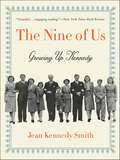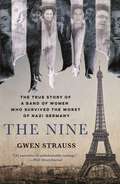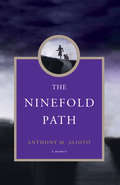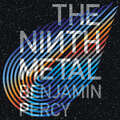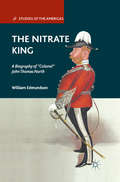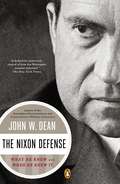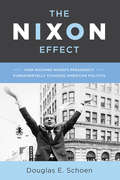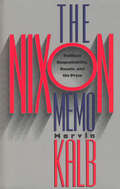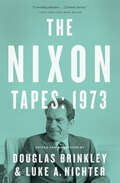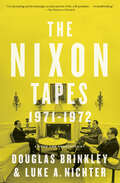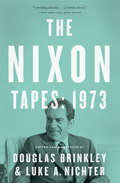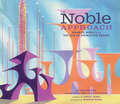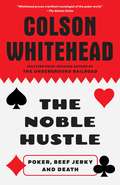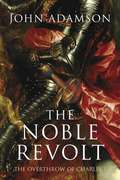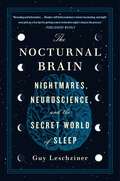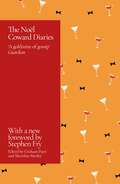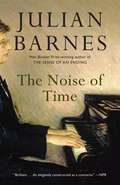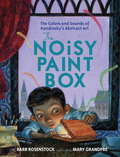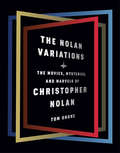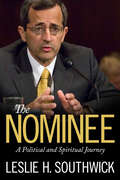- Table View
- List View
The Nine of Us: Growing Up Kennedy
by Jean Kennedy SmithIn this evocative and affectionate memoir, Ambassador Jean Kennedy Smith, the last surviving child of Joe and Rose Kennedy, offers an intimate and illuminating look at a time long ago when she and her siblings, guided by their parents, laughed and learned a great deal under one roof.Prompted by interesting tidbits in the newspaper, Rose and Joe Kennedy would pose questions to their nine children at the dinner table. "Where could Amelia Earhart have gone?" "How would you address this horrible drought?" "What would you do about the troop movements in Europe?" It was a nightly custom that helped shape the Kennedys into who they would become.Before Joe and Rose’s children emerged as leaders on the world stage, they were a loving circle of brothers and sisters who played football, swam, read, and pursued their interests. They were children inspired by parents who instilled in them a strong work ethic, deep love of country, and intense appreciation for the sacrifices their ancestors made to come to America. "No whining in this house!" was their father’s regular refrain. It was his way of reminding them not to complain, to be grateful for what they had, and to give back. In her remarkable memoir, Kennedy Smith—the last surviving sibling—revisits this singular time in their lives. Filled with fascinating anecdotes and vignettes, and illustrated with dozens of family pictures, The Nine of Us vividly depicts this large, close-knit family during a different time in American history. Kennedy Smith offers indelible, elegantly rendered portraits of her larger-than-life siblings and her parents. "They knew how to cure our hurts, bind our wounds, listen to our woes, and help us enjoy life," she writes. "We were lucky children indeed."
The Nine: The True Story of a Band of Women Who Survived the Worst of Nazi Germany
by Gwen Strauss"[A] narrative of unfathomable courage... Ms. Strauss does her readers—and her subjects—a worthy service by returning to this appalling history of the courage of women caught up in a time of rapacity and war." —Wall Street Journal"Utterly gripping." —Anne Sebba, author of Les Parisiennes "A compelling, beautifully written story of resilience, friendship and survival. The story of Women’s resistance during World War II needs to be told and The Nine accomplishes this in spades." —Heather Morris, New York Times bestselling author of Cilka's JourneyThe Nine follows the true story of the author’s great aunt Hélène Podliasky, who led a band of nine female resistance fighters as they escaped a German forced labor camp and made a ten-day journey across the front lines of WWII from Germany back to Paris.The nine women were all under thirty when they joined the resistance. They smuggled arms through Europe, harbored parachuting agents, coordinated communications between regional sectors, trekked escape routes to Spain and hid Jewish children in scattered apartments. They were arrested by French police, interrogated and tortured by the Gestapo. They were subjected to a series of French prisons and deported to Germany. The group formed along the way, meeting at different points, in prison, in transit, and at Ravensbrück. By the time they were enslaved at the labor camp in Leipzig, they were a close-knit group of friends. During the final days of the war, forced onto a death march, the nine chose their moment and made a daring escape.Drawing on incredible research, this powerful, heart-stopping narrative from Gwen Strauss is a moving tribute to the power of humanity and friendship in the darkest of times.
The Ninefold Path
by Anthony M. AliotoAnthony Alioto was diagnosed with end stage renal disease in 1993 and was forced to go on dialysis for several years before receiving a successful kidney transplant in 2000. "In The Ninefold Path," he invites readers to join him on a harrowing personal journey through a labyrinth of tests, OC what can I expectOCO meetings with medical staff, surgeries, and near-death experiences. He spares no detail in his desire to provide a guide for others living with a chronic disease OCo and their families and friends OCo on how to navigate the oftentimes rough waters of modern medicine. "The Ninefold Path" is for all of those wearily traveling through chronic illnesses and for those by their sides wondering what to do, it is a celebration of the extraordinary individuals in medicine who relieve the suffering of strangers each and every day. In cataloging detail, there is inspiration, plus a call to compassion and serenity. A Note to the Reader from "The Ninefold Path": OC The reader can expect to encounter a very personal and human account of chronic illness, sometimes painful, sometimes hilarious, and then at times simply absurd OCo but, hopefully, also moving. One need not search for profound insights, recipes, therapy, or sage advice. It is my hope that you will come away with a feeling, a sense of being there, maybe a kind of liberation from the OCymerely personalOCO as Einstein phrased it, and a new appreciation for what others endure daily. Even in the midst of suffering physical pain and mental anguish, a person may yet gain the freedom to live a life of celebration, joy, compassion, and serenity. Zen Master Kyong Ho once said, OCyDonOCOt hope for life without problems. An easy life results in a judgmental and lazy mind. OCOOCO"
The Ninth Metal: The Comet Cycle Book 1 (The Comet Cycle #1)
by Benjamin PercyFrom award-winning author Benjamin Percy comes an explosive, breakout speculative thriller in which a powerful new metal arrives on Earth in the wake of a meteor shower, triggering a massive new 'gold rush' in the Midwest and turning life as we know it on its head. The first of a cycle of novels set in a shared universe. It might have been the end of days. Instead it was the beginning of something shockingly new. They called the comet Cain, after the astronomer who discovered it. It passed 500,000 miles from Earth. We were spared planetary destruction and granted a light show like no other. But, one year later, Earth span into the debris field left by the comet and a meteor storm struck. Roads, buildings and even a small town were annihilated.The meteors impacted heavily around the dying mining town of Northfall, Minnesota. It was the night of a mysterious double murder, the deed overshadowed by the discovery that the burning remains of the rock contained an unknown substance more precious than gold: the Ninth Metal. And with that discovery, everything changed.Benjamin Percy is an award-winning novelist, celebrated comic books writer and author of the Wolverine podcast. The Ninth Metal is the first of a cycle of novels set in a shared universe. (P) 2021 Houghton Mifflin Harcourt
The Nitrate King
by William EdmundsonWilliam Edmundson examines the spectacular life story of 'Colonel' John Thomas North, also known as 'The Nitrate King,' a mechanic in Leeds who became one of the best-known and richest men of his time. Forgotten in Britain and vilified in Chile and Peru, this is the first biography of a controversial but compelling figure.
The Nixon Defense
by John W. DeanBased on Nixon's overlooked recordings, New York Times bestselling author John W. Dean connects the dots between what we've come to believe about Watergate and what actually happened Watergate forever changed American politics, and in light of the revelations about the NSA's widespread surveillance program, the scandal has taken on new significance. Yet remarkably, four decades after Nixon was forced to resign, no one has told the full story of his involvement in Watergate. In The Nixon Defense, former White House Counsel John W. Dean, one of the last major surviving figures of Watergate, draws on his own transcripts of almost a thousand conversations, a wealth of Nixon's secretly recorded information, and more than 150,000 pages of documents in the National Archives and the Nixon Library to provide the definitive answer to the question: What did President Nixon know and when did he know it? Through narrative and contemporaneous dialogue, Dean connects dots that have never been connected, including revealing how and why the Watergate break-in occurred, what was on the mysterious 18 1/2 minute gap in Nixon's recorded conversations, and more. In what will stand as the most authoritative account of one of America's worst political scandals, The Nixon Defense shows how the disastrous mistakes of Watergate could have been avoided and offers a cautionary tale for our own time.
The Nixon Defense
by John W. DeanBased on Nixon's overlooked recordings, New York Times bestselling author John W. Dean connects the dots between what we've come to believe about Watergate and what actually happened Watergate forever changed American politics, and in light of the revelations about the NSA's widespread surveillance program, the scandal has taken on new significance. Yet remarkably, four decades after Nixon was forced to resign, no one has told the full story of his involvement in Watergate. In The Nixon Defense, former White House Counsel John W. Dean, one of the last major surviving figures of Watergate, draws on his own transcripts of almost a thousand conversations, a wealth of Nixon's secretly recorded information, and more than 150,000 pages of documents in the National Archives and the Nixon Library to provide the definitive answer to the question: What did PresidentNixon know and when did he know it? Through narrative and contemporaneous dialogue, Dean connects dots that have never been connected, including revealing how and why the Watergate break-in occurred, what was on the mysterious 18 1/2 minute gap in Nixon's recorded conversations, and more. In what will stand as the most authoritative account of one of America's worst political scandals, The Nixon Defense shows how the disastrous mistakes of Watergate could have been avoided and offers a cautionary tale for our own time.
The Nixon Defense: What He Knew and When He Knew It
by John W. DeanBased on Nixon's overlooked recordings, New York Times bestselling author John W. Dean connects the dots between what we've come to believe about Watergate and what actually happened Watergate forever changed American politics, and in light of the revelations about the NSA's widespread surveillance program, the scandal has taken on new significance. Yet remarkably, four decades after Nixon was forced to resign, no one has told the full story of his involvement in Watergate. In The Nixon Defense, former White House Counsel John W. Dean, one of the last major surviving figures of Watergate, draws on his own transcripts of almost a thousand conversations, a wealth of Nixon's secretly recorded information, and more than 150,000 pages of documents in the National Archives and the Nixon Library to provide the definitive answer to the question: What did PresidentNixon know and when did he know it? Through narrative and contemporaneous dialogue, Dean connects dots that have never been connected, including revealing how and why the Watergate break-in occurred, what was on the mysterious 18 1/2 minute gap in Nixon's recorded conversations, and more. In what will stand as the most authoritative account of one of America's worst political scandals, The Nixon Defense shows how the disastrous mistakes of Watergate could have been avoided and offers a cautionary tale for our own time.From the Trade Paperback edition.
The Nixon Effect
by Douglas E. SchoenThe Nixon Effect examines the 37th president's political legacy in broad-ranging ways that make clear, for the first time, the breadth and duration of his influence on American political life. The book argues that Nixon is the key political figure in postwar American politics in multiple ways, some barely acknowledged until now. His legacy includes a generational shift in the ideological orientations of both the Republican and Democratic parties; the Nixon influence, both intentional and unintentional, was to push both parties further out to their ideological poles. So stark was Nixon's influence on party identities that it shaped the hardened partisan polarization in Washington today and the evolution of what has come to be called Red and Blue America.Stemming in part from this, and also from Nixon's scorched-earth political warfare and eventually his Watergate scandal, we have also seen the evolution of politics as war, where adversaries and ideological opponents are seen as evil or unpatriotic. Finally, Nixon's pioneering tactics-from the identification of the Silent Majority to the Southern Strategy, from "triangulating" between both parties and claiming the political center to launching the culture war with attacks on "elites" in media, academia, and the courts-have shaped political communications and strategy ever since.Other books have argued for Nixon's importance, but Douglas E. Schoen's is the first to take into account the full range of this fascinating man's influence. While not discounting Nixon's many misdeeds, Schoen treats his presidency and its importance with the seriousness-and evenhandedness-that the subject deserves.
The Nixon Memo: Political Respectability, Russia, and the Press
by Marvin KalbAn absorbing example of political journalism, The Nixon Memo is a case study of Richard Nixon's relentless quest for political rehabilitation. At issue is the key role of this former president of the United States (best known for his involvement in the famous "watergate" scandal) in the post-cold war debate about aiding Russia in its uncertain revolution. The story begins on March 10, 1992. Nixon had written a private memo critical of president George Bush's policy toward Russia. The memo leaked and exploded on the front page of The New York Times. Why would Nixon attack Bush, a fellow party member fighting for re-election? Why on an issue of foreign affairs, which was Bush's strength? The questions are as intriguing as the answers, and distinguished journalist and scholar Marvin Kalb offers a suspenseful, eye-opening account of how our conventional wisdom on United States foreign policy is shaped by the insider's game of press/politics. This story of Nixon's Machiavellian efforts to pressure the White House, by way of the press, into helping Boris Yeltsin and Russia sheds new light on the inner workings of the world inside the government of the United States. Marvin Kalb read the documents behind the Nixon memo and interviewed scores of journalists, scholars, and officials in and from Washington and Moscow. Drawing on his years of experience as a diplomatic correspondent, he identifies and illuminates the intersection of press and politics in the fashioning of public policy. "An absorbing and often compelling argument that Richard Nixon directed his own political rehabilitation on the world stage, using presidents, lesser politicians, and the press as his supporting cast. This is a first-class job of unraveling a complex and usually unseen tapestry."—Ted Koppel "With Marvin Kalb's captivating account, Richard Nixon continues to fascinate us even in death."—Al Hunt
The Nixon Tapes (With Audio Clips): 1973 (WITH AUDIO CLIPS)
by Douglas Brinkley, Luke A. NichterWith audio clips included, this &“revealing&” transcription captures a dark and dramatic year in presidential history—and the words of Richard Nixon himself (The New York Times Book Review). Between 1971 and 1973, President Richard Nixon&’s voice-activated tape recorders captured 3,700 hours of conversations. Douglas Brinkley and Luke Nichter&’s intrepid two-volume transcription and annotation of the highlights of this essential archive provides an unprecedented and fascinating window into the inner workings of a momentous presidency. The Nixon Tapes: 1973 tells the concluding chapter of the story, the final year of taping, covering such events as the Vietnam cease-fire, the Wounded Knee standoff, and, of course, the Watergate investigation. Once again, there are revelations on every page. With Nixon&’s landslide 1972 reelection victory receding into the background and the scandal that would scuttle the administration looming, The Nixon Tapes: 1973 reveals the inside story of the tragedy that followed the triumph.
The Nixon Tapes: 1971–1972 (With Audio Clips)
by Douglas Brinkley, Luke A. NichterAn enhanced edition of this &“fascinating&” collection of White House transcripts, including audio clips of some of the most newsworthy conversations (San Francisco Chronicle). This &“treasure trove&” of transcripts documents two years of Richard Nixon&’s presidency and takes you directly inside the White House, through the famous—and infamous—Nixon White House tapes that reveal for the first time the president uncensored, unfiltered, and in his own words (TheBoston Globe). President Nixon&’s voice-activated taping system captured every word spoken in the Oval Office, Cabinet Room, other key locations in the White House, and at Camp David—3,700 hours of recordings between 1971 and 1973. Yet less than five percent of those conversations have ever been transcribed and published. Now, thanks to historian Luke Nichter&’s massive effort to digitize and transcribe the tapes, the world can finally read an unprecedented account of one of the most important and controversial presidencies in US history. This volume of The Nixon Tapes offers a selection of fascinating scenes from the period in which Nixon opened relations with China, negotiated the SALT I arms agreement with the Soviet Union, and won a landslide reelection victory. All the while, the growing shadow of Watergate and Nixon&’s political downfall crept ever closer. The Nixon Tapes provides a never-before-seen glimpse into a flawed president&’s hubris, paranoia, and political genius—&“essential for students of the era and fascinating for those who lived it&” (Kirkus Reviews, starred review).
The Nixon Tapes: 1973
by Douglas Brinkley, Luke A. NichterThis &“revealing&” transcription captures a dark and dramatic year in presidential history—and the words of Richard Nixon himself (The New York Times Book Review). Between 1971 and 1973, President Richard Nixon&’s voice-activated tape recorders captured 3,700 hours of conversations. Douglas Brinkley and Luke Nichter&’s intrepid two-volume transcription and annotation of the highlights of this essential archive provides an unprecedented and fascinating window into the inner workings of a momentous presidency. The Nixon Tapes: 1973 tells the concluding chapter of the story, the final year of taping, covering such events as the Vietnam cease-fire, the Wounded Knee standoff, and, of course, the Watergate investigation. Once again, there are revelations on every page. With Nixon&’s landslide 1972 reelection victory receding into the background and the scandal that would scuttle the administration looming, The Nixon Tapes: 1973 reveals the inside story of the tragedy that followed the triumph.
The Nobel Peace Prize and the Laureates: An Illustrated Biographical History, 1901-1987
by Irwin AbramsHistory of the Nobel Peace Prize itself as well as those who have won it through 1987.
The Noble Approach: Maurice Noble and the Zen of Animation Design
by Tod PolsonThis extraordinary volume examines the life and animation philosophy of Maurice Noble, the noted American animation background artist and layout designer whose contributions to the industry span more than 60 years and include such cartoon classics as Duck Dodgers in the 24 ½th Century, What's Opera, Doc?, and The Road Runner Show. Revered throughout the animation world, his work serves as a foundation and reference point for the current generation of animators, story artists, and designers. Written by Noble's longtime friend and colleague Tod Polson and based on the draft manuscript Noble worked on in the years before his death, this illuminating book passes on his approach to animation design from concept to final frame, illustrated with sketches and stunning original artwork spanning the full breadth of his career.
The Noble Hustle
by Colson WhiteheadThe Noble Hustle is Pulitzer finalist Colson Whitehead's hilarious memoir of his search for meaning at high stakes poker tables, which the author describes as "Eat, Pray, Love for depressed shut-ins." On one level, The Noble Hustle is a familiar species of participatory journalism--a longtime neighborhood poker player, Whitehead was given a $10,000 stake and an assignment from the online online magazine Grantland to see how far he could get in the World Series of Poker. But since it stems from the astonishing mind of Colson Whitehead (MacArthur Award-endorsed!), the book is a brilliant, hilarious, weirdly profound, and ultimately moving portrayal of--yes, it sounds overblown and ridiculous, but really!--the human condition. After weeks of preparation that included repeated bus trips to glamorous Atlantic City, and hiring a personal trainer to toughen him up for sitting at twelve hours a stretch, the author journeyed to the gaudy wonderland that is Las Vegas - the world's greatest "Leisure Industrial Complex" -- to try his luck in the multi-million dollar tournament. Hobbled by his mediocre playing skills and a lifelong condition known as "anhedonia" (the inability to experience pleasure) Whitehead did not - spoiler alert! - win tens of millions of dollars. But he did chronicle his progress, both literal and existential, in this unbelievably funny, uncannily accurate social satire whose main target is the author himself. Whether you've been playing cards your whole life, or have never picked up a hand, you're sure to agree that this book contains some of the best writing about beef jerky ever put to paper.From the Hardcover edition.
The Noble Revolt: The Overthrow of Charles I
by John AdamsonIn The Noble Revolt, John Adamson traces the careers and fortunes of the small group of noblemen who risked their lives and fortunes to challenge Charles I's attempt to refashion his three kingdoms as an authoritarian monarchy. Beginning with a core of little more than a dozen, this aristocratic leadership exploited a contemporary rebellion against Charles's rule in Scotland to create an entirely new political order in England: an essentially republican state in which executive power was monopolized by a small cartel of noblemen, answerable to Parliament, and where the monarch was permanently reduced to the status of a figurehead king. What was achieved in the 'year of wonders', 1641, astonished - and alarmed - contemporary Europe: the public trial and execution of the king's greatest minister; the monarch himself stripped of most of his sources of revenue; the transference of executive power to a new 'godly' noble-dominated cartel; and a new, sometimes violent, phase of reformation in the English Church.Far from this being a slow, almost accidental build-up to the outbreak of armed hostilities between the king and Parliament in 1642, Adamson argues that the noblemen opposed to Charles I had made contingency plans for, and publicly justified, armed resistance to the king even before the Parliament had first met in 1640. Indeed, during the creation of England's 'monarchical republic', the threat of civil war had rarely been absent. And as the new oligarchic regime began to assert its newly won authority in the summer of 1641, its ambition and radicalism triggered a series of reactions that made the resort to hostilities seem - on both sides - a viable, perhaps even attractive, means of resolving the conflict.Based on a mass of newly discovered evidence, The Noble Revolt offers the most comprehensive and detailed re-evaluation of the origins of the English Civil War for over a century. The sequel, The War of the Realms, was published in 2007.
The Nocturnal Brain: Nightmares, Neuroscience, and the Secret World of Sleep
by Dr. Guy LeschzinerA renowned neurologist shares the true stories of people unable to get a good night’s rest in The Nocturnal Brain: Nightmares, Neuroscience, and the Secret World of Sleep, a fascinating exploration of the symptoms and syndromes behind sleep disorders.For Dr. Guy Leschziner’s patients, there is no rest for the weary in mind and body. Insomnia, narcolepsy, night terrors, apnea, and sleepwalking are just a sampling of conditions afflicting sufferers who cannot sleep—and their experiences in trying are the stuff of nightmares. Demoniac hallucinations frighten people into paralysis. Restless legs rock both the sleepless and their sleeping partners with unpredictable and uncontrollable kicking. Out-of-sync circadian rhythms confuse the natural body clock’s days and nights.Then there are the extreme cases. A woman in a state of deep sleep who gets dressed, unlocks her car, and drives for several miles before returning to bed. The man who has spent decades cleaning out kitchens while “sleep-eating.” The teenager prone to the serious, yet unfortunately nicknamed Sleeping Beauty Syndrome stuck in a cycle of excessive unconsciousness, binge eating, and uncharacteristic displays of aggression and hypersexuality while awake.With compassionate stories of his patients and their conditions, Dr. Leschziner illustrates the neuroscience behind our sleeping minds, revealing the many biological and psychological factors necessary in getting the rest that will not only maintain our physical and mental health, but improve our cognitive abilities and overall happiness.
The Noel Coward Diaries: With a Foreword by Stephen Fry
by Sheridan Morley Graham Payn'A gold mine of gossip with a cast of thousands' GUARDIANThe unexpurgated diaries of one of the greatest, most talented, and wittily flamboyant characters of the 20th century - with a new introduction by Stephen Fry'Compulsive reading' SUNDAY TIMES'19th February 1956. A A Milne has died. Lord Beaverbrook has not ... Larry is going to make a movie of The Sleeping Prince with Marilyn Monroe, which might conceivably drive him round the bend''28th February 1960 Princess Margaret has announced her engagement to Tony Armstrong-Jones ... He looks quite pretty, but whether or not the marriage is entirely suitable remains to be seen.'Noel Coward was a renowned actor, dramatist, director - and star. His incredible zest, versatility and unrivalled wit are revealed in these diaries, with a cast of characters ranging from The Beatles to the Queen, Churchill to Marilyn Monroe.Touching, funny and revealing, THE NOEL COWARD DIARIES is a superb account of one of the greatest entertainers of all time.
The Noel Coward Diaries: With a Foreword by Stephen Fry
by Sheridan Morley Graham Payn'A gold mine of gossip with a cast of thousands' GUARDIANThe unexpurgated diaries of one of the greatest, most talented, and wittily flamboyant characters of the 20th century - with a new introduction by Stephen Fry'Compulsive reading' SUNDAY TIMES'19th February 1956. A A Milne has died. Lord Beaverbrook has not ... Larry is going to make a movie of The Sleeping Prince with Marilyn Monroe, which might conceivably drive him round the bend''28th February 1960 Princess Margaret has announced her engagement to Tony Armstrong-Jones ... He looks quite pretty, but whether or not the marriage is entirely suitable remains to be seen.'Noel Coward was a renowned actor, dramatist, director - and star. His incredible zest, versatility and unrivalled wit are revealed in these diaries, with a cast of characters ranging from The Beatles to the Queen, Churchill to Marilyn Monroe.Touching, funny and revealing, THE NOEL COWARD DIARIES is a superb account of one of the greatest entertainers of all time.
The Noise of Time
by Julian BarnesA masterful novel dedicated to the Russian composer Dmitri Shostakovich, from the bestselling, Booker Prize-winning author of The Sense of an Ending.The book begins in 1936, with Dmitri Shostakovich petrified at the age of thirty and fearing for his livelihood and even his life. His opera Lady Macbeth of the Mtsensk District has just been denounced in Pravda in an article that certainly reflects the opinion of Joseph Stalin himself. Every night he waits on the landing outside his apartment, expecting NKVD agents to come and whisk him away. Shostakovich reflects on not only his predicament but also his own personal history, his parents and his various women and wives and his children, and all who are still alive themselves hang in the balance of his fate. When the interrogation he fears does eventually arrive, a stroke of luck prevents him from becoming a casualty of the Great Terror that claims so many of his friends and contemporaries--"chips that had flown while the wood was being chopped." Still, the spectre of the government hovers over him for several further decades, forcing him to constantly weigh the merits of appeasing those in power against the integrity of his music. Barnes elegantly guides us through subsequent stages of Shostakovich's life, from being ground into the dirt under the thumb of despotism to being made to serve as a figurehead of Soviet values at a cultural conference in New York, and finally being forced into joining the Party. The trajectory of his career illuminates the evolution of the Soviet Union, with Nikita Khrushchev assuming its leadership, this providing no great joy to Shostakovich. The Noise of Time is both a heartbreaking account of a relentlessly fascinating man's experience and a brilliant meditation on the meaning of art and its place in society.
The Noise of Time: A novel (Vintage International Series)
by Julian BarnesA compact masterpiece dedicated to the Russian composer Dmitri Shostakovich: Julian Barnes's first novel since his best-selling, Man Booker Prize-winning The Sense of an Ending. In 1936, Shostakovich, just thirty, fears for his livelihood and his life. Stalin, hitherto a distant figure, has taken a sudden interest in his work and denounced his latest opera. Now, certain he will be exiled to Siberia (or, more likely, executed on the spot), Shostakovich reflects on his predicament, his personal history, his parents, various women and wives, his children--and all who are still alive themselves hang in the balance of his fate. And though a stroke of luck prevents him from becoming yet another casualty of the Great Terror, for decades to come he will be held fast under the thumb of despotism: made to represent Soviet values at a cultural conference in New York City, forced into joining the Party and compelled, constantly, to weigh appeasing those in power against the integrity of his music. Barnes elegantly guides us through the trajectory of Shostakovich's career, at the same time illuminating the tumultuous evolution of the Soviet Union. The result is both a stunning portrait of a relentlessly fascinating man and a brilliant exploration of the meaning of art and its place in society.From the Hardcover edition.
The Noisy Paint Box: The Colors and Sounds of Kandinsky's Abstract Art
by Mary Grandpre Barb RosenstockVasya Kandinsky was a proper little boy: he studied math and history, he practiced the piano, he sat up straight and was perfectly polite. And when his family sent him to art classes, they expected him to paint pretty houses and flowers--like a proper artist. But as Vasya opened his paint box and began mixing the reds, the yellows, the blues, he heard a strange sound--the swirling colors trilled like an orchestra tuning up for a symphony! And as he grew older, he continued to hear brilliant colors singing and see vibrant sounds dancing. But was Vasya brave enough to put aside his proper still lifes and portraits and paint . . . music? In this exuberant celebration of creativity, Barb Rosenstock and Mary GrandPré tell the fascinating story of Vasily Kandinsky, one of the very first painters of abstract art. Throughout his life, Kandinsky experienced colors as sounds, and sounds as colors--and bold, groundbreaking works burst forth from his noisy paint box. Backmatter includes four paintings by Kandinsky, an author's note, sources, links to websites on synesthesia and abstract art.From the Hardcover edition.
The Nolan Variations: The Movies, Mysteries, and Marvels of Christopher Nolan
by Tom ShoneAn in-depth look at, and written in collaboration with, the man considered to be the most profound, and commercially successful director at work today--his work, including his latest blockbuster, the action-thriller/spy-fi Tenet ("Big, brashly beautiful, grandiosely enjoyable"--Variety); his influences, his vision, his enigmatic childhood past, and much more. With Nolan's never-before-seen photographs, storyboards, and scene sketches. "The Nolan Variations is that rare thing, a superb book about a living filmmaker. Erudite, complex, labyrinthine and mind-expanding--it's as close as you're ever going to get to the Escher drawing that is Christopher Nolan's remarkable brain."--Sam Mendes"Fabulous: intelligent, illuminating, rigorous, and highly readable. The very model of what a filmmaking study should be. Essential reading for anyone who cares about Nolan or about film for that matter."--Neal Gabler, author of An Empire of Their Own: How the Jews Invented Hollywood and Walt Disney, The BiographyA rare, intimate portrait of Christopher Nolan with the full cooperation of Nolan himself who opened up more fully than ever before in his talks with Tom Shone. In chapters structured by themes and motifs ("Time"; "Chaos"), Shone writes of Nolan's thoughts on movies, on plots; on time, identity, perception, chaos, daydreams.Here is Nolan on the evolution of his pictures, and the writers, artists, directors, and thinkers who have inspired and informed his films.To write the book, Tom Shone, who has known Nolan for more than two decades and who spent months with the director, was given unprecedented access to Nolan's notes, scripts, storyboards, and artwork.In this riveting portrait of an artist, Shone deftly navigates Nolan's themes, influences, and working methods (both in writing and directing). Here is his trans-Atlantic childhood ("It makes you feel very differently about the concept of 'home'") . . . how he dreamed up the plot of Inception lying awake one night in his dorm ("I prized the imaginative space of listening to music in the dark, thinking about things, imagining things, films, stories") . . . his color-blindness and its effect on Memento ("People are fascinated by other people's perception of the world and the way in which it differs") . . . his obsession with puzzles and optical illusions . . . and much, much more.
The Nominee: A Political and Spiritual Journey (Willie Morris Books in Memoir and Biography)
by Leslie H. SouthwickPresident George W. Bush nominated Leslie H. Southwick in 2007 to the federal appeals court, Fifth Circuit, based in New Orleans. Initially, Southwick seemed a consensus nominee. Just days before his hearing, though, a progressive advocacy group distributed the results of research it had conducted on opinions of the state court on which he had served for twelve years. Two opinions Southwick had signed off on but not written became the center of the debate over the next five months. One dealt with a racial slur by a state worker, the other with a child custody battle between a father and a bisexual mother. Apparent bipartisan agreement for a quick confirmation turned into a long set of battles in the Judiciary Committee, on the floor of the Senate, and in the media.In early August, Senator Dianne Feinstein completely surprised her committee colleagues by supporting Southwick. Hers was the one Democratic vote needed to move the nomination to the full Senate. Then in late October, by a two-vote margin, he received the votes needed to end a filibuster. Confirmation followed.Southwick recounts the four years he spent at the Department of Justice, the twelve years on a state court, and his military service in Iraq while deployed with a Mississippi National Guard Brigade. During the nomination inferno Southwick maintained a diary of the many events, the conversations and emails, the joys and despairs, and quite often, the prayers and sense of peace his faith gave him--his memoir bears significant spiritual content. Throughout the struggle, Southwick learned that perspective and growth are important to all of us when making decisions, and he grew to accept his critics, regardless of outcome. In The Nominee there is no rancor, and instead the book expresses the understanding that the difficult road to success was the most helpful one for him, both as a man and as a judge.
